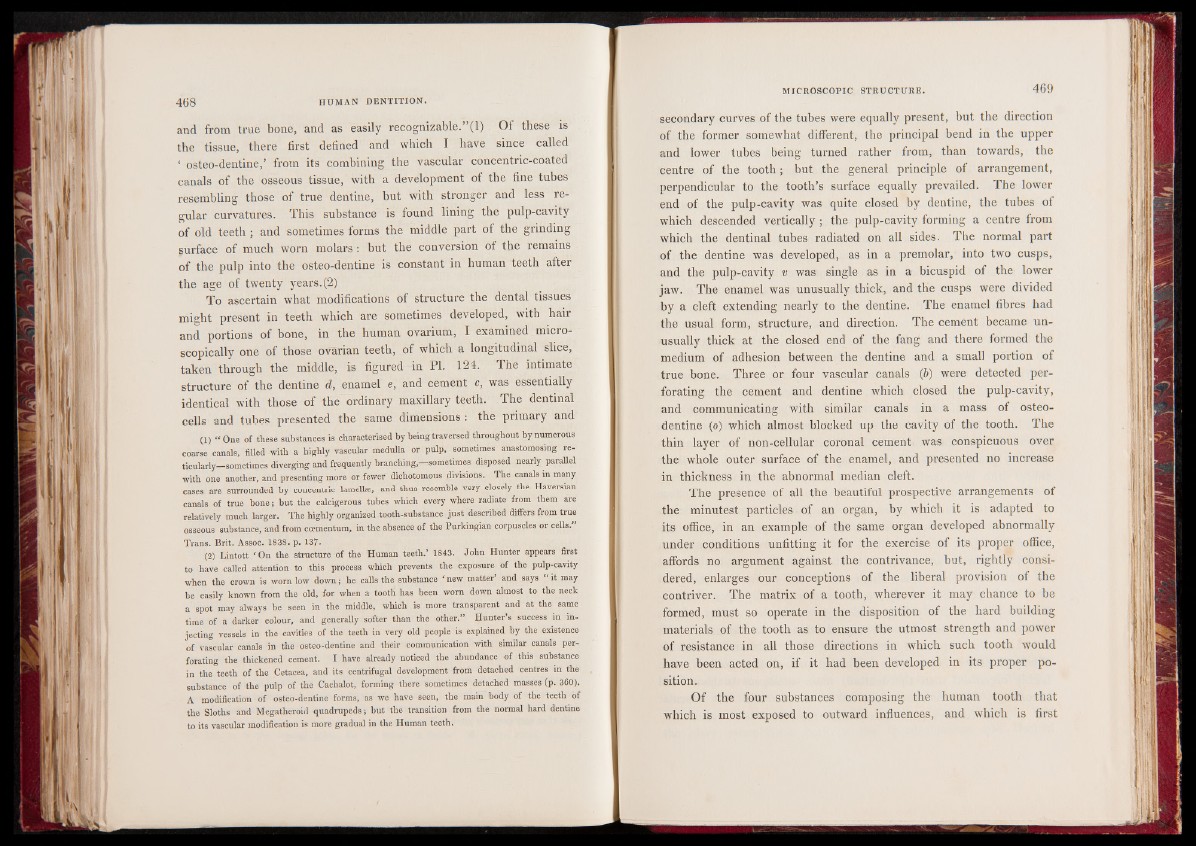
and from true bone, and as easily recognizable.”(l) Of these is
the tissue, there first defined and which I have since called
‘ osteo-dentine,’ from its combining the vascular concentric-coated
canals of the osseous tissue, with a development of the fine tubes
resembling those of true dentine, hut with stronger and less regular
curvatures. This substance is found lining the pulp-cavity
of old teeth ; and sometimes forms the middle part of the grinding
surface of much worn molars : but the conversion of the remains
of the pulp into the osteo-dentine is constant in human teeth after
the age of twenty years.(2)
To ascertain what modifications of structure the dental tissues
might present in teeth which are sometimes developed, with hair
and portions of hone, in the human ovarium, I examined microscopically
one of those ovarian teeth, of which a longitudinal slice,
taken through the middle, is figured in PL 124. The intimate
structure of the dentine d, enamel e, and cement c, was essentially
identical with those of the ordinary maxillary teeth. The dentinal
cells and tubes presented the same dimensions : the primary and
(1) “ One of these substances is characterised by being traversed throughout by numerous
coarse canals, filled with a highly vascular medulla or pulp, sometimes anastomosing re-
tieularly—sometimes diverging and frequently branching,—sometimes disposed nearly parallel
with one another, and presenting more or fewer dichotomous divisions. The canals m many
cases are surrounded by concentric lamellæ, and thus resemble very closely the Haversian
canals of true bone; but the calcigerous tubes which every where radiate from them are
relatively much larger. The highly organized tooth-substance just described differs from true
osseous substance, and from ccementum, in the absence of the Purkingian corpuscles or cells.
Trans. Brit. Assoc. 1838. p. 13/.
(21 Lintott ‘On the structure of the Human teeth.’ 1843. John Hunter appears first
to have called attention to this process which prevents the exposure of the pulp-cavity
when the crown is worn low down ; he calls the substance ‘ new matter and says it may
be easily known from the old, for when a tooth has been worn down almost to the neck
a spot may always be seen in the middle, which is more transparent and at the same
time of a darker colour, and generally softer than the other.” Hunter’s success in injecting
vessels in the cavities of the teeth in very old people is explained by the existence
of vascular canals in the osteo-dentine and their communication with similar canals perforating
the thickened cement. I have already noticed the abundance of this substance
in the teeth of the Cetacea, and its centrifugal development from detached centres in the
substance of the pulp of the Cachalot, forming there sometimes detached masses (p. 360).
A modification of osteo-dentine forms, as we have seen, the main body of the teeth of
the Sloths and Megatheroid quadrupeds ; but the transition from the normal hard dentine
to its vascular modification is more gradual in the Human teeth.
secondary curves of the tubes were equally present, but the direction
of the former somewhat different, the principal bend in the upper
and lower tubes being turned rather from, than towards, the
centre of the tooth; but the general principle of arrangement,
perpendicular to the tooth’s surface equally prevailed. The lower
end of the pulp-cavity was quite closed by dentine, the tubes of
which descended vertically ; the pulp-cavity forming a centre from
which the dentinal tubes radiated on all sides. The normal part
of the dentine was developed, as in a premolar, into two cusps,
and the pulp-cavity v was single as in a bicuspid of the lower
jaw. The enamel was unusually thick, and the cusps were divided
by a cleft extending nearly to the dentine. The enamel fibres had
the usual form, structure, and direction. The cement became unusually
thick at the closed end of the fang and there formed the
medium of adhesion between the dentine and a small portion of
true bone. Three or four vascular canals (b) were detected perforating
the cement and dentine which closed the pulp-cavity,
and communicating with similar canals in a mass of osteo-
dentine (o) which almost blocked up the cavity of the tooth. The
thin layer of non-cellular coronal cement was conspicuous over
the whole outer surface of the enamel, and presented no increase
in thickness in the abnormal median cleft.
The presence of all the beautiful prospective arrangements of
the minutest particles of an organ, by which it is adapted to
its office, in an example of the same organ developed abnormally
under conditions unfitting it for the exercise of its proper office,
affords no argument against the contrivance, but, rightly considered,
enlarges our conceptions of the liberal provision of the
contriver. The matrix of a tooth, wherever it may chance to be
formed, must so operate in the disposition of the hard building
materials of the tooth as to ensure the utmost strength and power
of resistance in all those directions in which such tooth would
have been acted on, if it had been developed in its proper position
.O
f the four substances composing the human tooth that
which is most exposed to outward influences, and which is first